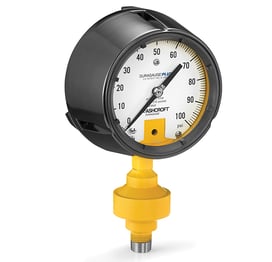
By:
Lance Dillon
Territory Sales Manager
Published on:
March 27th, 2024
Subscribe now and get the latest blog posts delivered straight to your inbox.
Selecting Safe Instrumentation for Acid Applications

By:
Lance Dillon
Territory Sales Manager
Published on:
March 27th, 2024

This article was originally published on March 27, 2023, and was updated on March 27, 2024.
Working in the oil and gas or chemical industries means your process and your people are exposed to dangerous acids and chemicals. Chemicals such as hydrofluoric acid and others can create dangerous conditions and corrode certain materials, which could result in hazardous leaks. That's why it is imperative to select pressure and temperature instrumentation that can safeguard your entire operation from the potentially damaging effects of these applications.
While dangerous acids have been safely used in industrial applications for many years, specifying proper pressure instrumentation with the appropriate wetted materials for these locations, requires unique expertise. That's where Ashcroft can help. With decades of experience in pressure and temperature instrumentation for the process industry, we have guided customers to the information they need to ensure they are choosing the safest instrumentation for their acid application.
This article will discuss the safety concerns for harsh acid applications and what types of pressure instruments can best handle these challenging working environments. When you are done reading, you will also find additional resources that you can use as a reference for this topic.
Safety Concerns
Hydrogen Fluoride (HF) is used as a catalyst in the alkylation process - taking short-chain olefins (propylene/butylene) and combining them with isobutane (all gasses) into larger molecules suitable for motor fuels. This “Alkylate” is used as a blending stock for high-octane gasoline.
There are several safety concerns to consider in acid applications:
- Elevated temperature
- Leak paths
- Material compatibility of diaphragm seals
When released in the atmosphere, HF rapidly forms dense vapor clouds that can cause severe burns and injuries to the eyes, nose, throat and respiratory system. Therefore, process containment is vital. You need instrumentation and equipment that can keep dangerous materials from escaping.
Acid Leak Detection
If your process experiences a leak, there isn’t much time to contain the acid. A visual warning can help you identify a problem and alert you to shut down your process immediately before anyone is injured.
Ashcroft manufactures an Acid Lead Detection (ALD) gauge/diaphragm seal assembly for these instances. It uses a special yellow coating that changes to red once it is exposed to acids with a pH of ≤ 3.0, providing a visual indication of a process media leak.
Leak point(s) that can be visually detected when acid encounters the sensing coating:
- top to lower housing weld
- diaphragm weld
- gauge to seal weld
- bourdon tube system leak
ALD also features a dual containment for safety and is available with pressure ranges to 10,000 psi.

ALD is available in orange or yellow gauge cases for easy identification. It is also available with Halocarbon® fill for oxidizing acids and silicone-free PLUS!™ Performance. Read our case study to see how ALD offered a solution to a challenging HF application.
For other hazardous conditions such as elevated temperature or excessive pulsation, consider additional devices to help protect your instrument. These can be used in conjunction with the ALD design.
Material Selection
The materials you select for your instruments in acid applications must be able to withstand the harsh acid effects. There are a number of materials used in different applications that are not compatible with the acids. The wetted material selection is especially important in specifying diaphragm seals. The diaphragm themselves are very thin by design and must provide enough displacement to drive the instrument.
A thicker material would be less sensitive. Because the diaphragm is thin, it is more vulnerable to any type of harsh condition – including corrosion, erosion and pitting. It requires a highly resistant material to prevent it from permeation or complete failure.
Stainless steel would corrode in acid, and while Monel® offers acceptable resistance to HF, the gauge alone provides only single containment of the process media. A welded assembly gives you secondary containment and prevents possible leak paths. Similar metals (or accessories such as temperature dissipaters or snubbers and isolators together) need to be used when welding instruments.
Note: Whenever the ALD is being specified for an HF application, we recommend you contact our factory material specialists to confirm compatibility.
Hastelloy® and Tantalum materials are often used and hold up well in many acidic applications. If you need to identify what materials are best for your application, you can use the Ashcroft® Material Selector and Corrosion Guide for reference.
You can also use Ashcroft’s Product Configurator to find the right instrument to meet your application’s requirements.
Ready to learn more?
Now that you know the factors to consider when choosing the right pressure and temperature measurement instruments, you can research the best solution for your acid application.
Keeping these factors in mind can help you avoid equipment damage or operator injury and keep your process running, even in harsh chemical conditions.
If you want to learn more, here are some additional resources for you to explore.
- Acid Leak Detection (ALD) Video
- Choosing Measurement Instruments for the Chemical Industry
- Best Pressure Gauges for Ammonia Plant Applications
- Fill Fluid Options for Pressure Instruments
- When to Use a Welded Instrument Assembly
Feel free to contact us today to talk to one of our industry experts and get your questions answered.
Lance Dillon, Territory Sales Manager
Lance Dillon is the Territory Sales Manager for Ashcroft responsible for supporting distribution and OEM customers in the Northwest for the past 10 years. Prior to that, he was the Branch Manager at an Ashcroft distributor (including an onsite instrument shop providing diaphragm seal assembly and repair) for 23 years supporting end users with the complete Ashcroft product line.


















